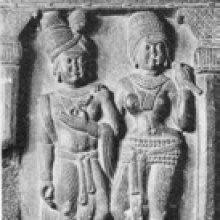Hawk: 1 definition
Introduction:
Hawk means something in Buddhism, Pali. If you want to know the exact meaning, history, etymology or English translation of this term then check out the descriptions on this page. Add your comment or reference to a book if you want to contribute to this summary article.
Images (photo gallery)
In Buddhism
Tibetan Buddhism (Vajrayana or tantric Buddhism)
Source: academia.edu: The Structure and Meanings of the Heruka MaṇḍalaThe Hawk (animal) is associated with the Yoginī (female deity) named Senā or Śyenā, being situated in the Vāyucakra, according to the 10th century Ḍākārṇava-tantra: one of the last Tibetan Tantric scriptures belonging to the Buddhist Saṃvara tradition consisting of 51 chapters.—Accordingly, the vāyucakra refers to one of the three divisions of the dharma-puṭa (‘dharma layer’), situated in the Herukamaṇḍala. The 36 pairs of Ḍākinīs [viz., Senā or Śyenā—“Hawk”] and Vīras are dark blue in color; they each have one face and four arms; they hold a skull bowl, a skull staff, a small drum, and a knife.

Tibetan Buddhism includes schools such as Nyingma, Kadampa, Kagyu and Gelug. Their primary canon of literature is divided in two broad categories: The Kangyur, which consists of Buddha’s words, and the Tengyur, which includes commentaries from various sources. Esotericism and tantra techniques (vajrayāna) are collected indepently.
See also (Relevant definitions)
Starts with: Hawk raspberry, Hawks Of Nephthys, Hawktiphai.
Ends with: Unchu-khawk.
Full-text (+877): Shyena, Shyenacit, Sena, Shashadana, Vegin, Satkanda, Kapotari, Ghatipakshin, Khankaranem, Picchavana, Khagantaka, Picchabana, Patadbhiru, Apatika, Palanka, Mushtimoka, Hastamoka, Anguli, Mushti, Parikshepa.
Relevant text
Search found 96 books and stories containing Hawk; (plurals include: Hawks). You can also click to the full overview containing English textual excerpts. Below are direct links for the most relevant articles:
The Jataka tales [English], Volume 1-6 (by Robert Chalmers)
Jataka 218: Kūṭa-Vāṇija-jātaka < [Book II - Dukanipāta]
Jataka 486: Mahā-Ukkusa-jātaka < [Volume 4]
Jataka 330: Sīlavīmaṃsa-jātaka < [Volume 3]
Mahabharata (English) (by Kisari Mohan Ganguli)
Section CCXXXIII < [Khandava-daha Parva]
Section CXXXI < [Tirtha-yatra Parva]
Section XXXII < [Anusasanika Parva]
Rig Veda (translation and commentary) (by H. H. Wilson)
Egypt Through The Stereoscope (by James Henry Breasted)
Position 97 - Interior Of The Rock-hewn Temple Of Abu Simbel, Showing The Holy Of Holies, With The Statues Of The Gods In The Rear < [Standpoints In Egypt]
Position 96 - Looking Up The River Across The Front Of The Abu Simbel Temple, From The Sand Drift At The North < [Standpoints In Egypt]
Animal Kingdom (Tiryak) in Epics (by Saranya P.S)
Chapter 6.3 - The hawk-dove debate (Shyena Kapota Samvada)
Chapter 6.13 - Tuladhara Jajali debate
The Gods of the Egyptians Vol 1 (by E. A. Wallis Budge)
